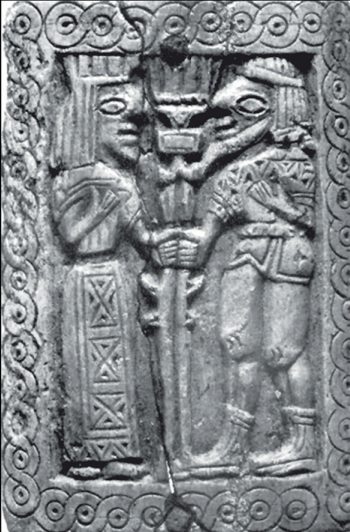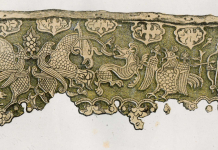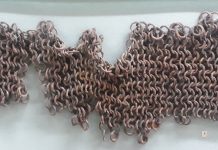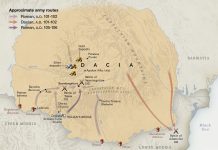Iryna Shramko an Assistant Professor at V. N. Karazin Kharkiv National University wrote in a scientific article The Dentine Enigma of Western Bilsk: “A curious ivory artifact was discovered in the Early Scythian habitation context. It represents a bulk of dentine taken from a grooved and riveted joint and reshaped into a wedged tool… In 1996, another portion of the ashmound No. 28 was explored within the western fortified area of the Bilsk City-site… It was in the archaeological context of homestead No. 1, that a thought-provoking object was found. Over the years, it has only been accessible through a field report. The find now reposes in the Museum of Archaeology of V. N. Karazin Kharkiv National University (inv. No. ВН—334). The preserved sample has 88.5 mm of length, 19.5 mm for maximum width, and 7.7 mm of thickness. To begin with, it consists of the substance of a gigantic tooth. Having thin layered and fine-wavy structures on the broad end as well as on the sides of the sample at our disposal, an Elephantidae tusk is most expected…
Looking for the closest similarities, we turn to the Late Geometric ivory plaques of the late 8th — early 7th century BC from the Orthia sanctuary in Sparta. Linear, notched, and circular elements are combined there with figurative carving in relief. To adorn the aprons, coats, and wings of human-like figures (and of the Πότνιαι in particular), a saltire with notched triangles and a zigzag band with the same notches were used. Specifically, both motives may be interpreted as the recurring merger of deltas with triangles within, but when the bases of the deltas of the neighboring saltires are connected, a real bisected lozenge comes to light, with the triangle notch in each half.

It is, however, the Early Orientalizing times ivory figurine of the first half of the 7th century BC from Crete that provides the most striking resemblance to the ivory No. 5266 of Bilsk. In the Idaean Cave, the upright panel of the garment is organized like an argyle structure of double-ranked lozenges and deltas; each lozenge is filled in with two triangular notches, their vertices directed oppositely, so they form a sort of bisected rhombus, although another Cretan work is known to contain true rhombi within lozenge cells. The peculiarity of the Bilsk ivory is that the mid-axial groove introduces a new complexity to the composition by rearranging its elements. As a result, some lozenges only contain a single notch which is semi-isomorphic to the cell it fills in, whereas a median rank of neighboring deltas and not ches, which form a bisected rhombus, supplements the whole pattern with the sought-for symmetry.

In contrast to Laconia, both in Crete and Bilsk, four notched triangles are not observed to converge with their vertices towards the junction of the saltire.
…A cautious assumption may follow that the ivory find from Bilsk could originally represent a highly schematized apron of a statuette of a goddess and/or priestess from somewhere in the Aegean or the Eastern Mediterranea.
It would seem that the outstanding finds in Bilsk and Pastyrske are closely, if not immediately, related with the works and days of far-distant western ergasteria and separated from comparable pursuits in their closest environments.
The oldest known Ivory Artifacts with Geometric patterns >
The “Cradle of Civilizations” book has little-known insights into the ties between ‘Ukrainian’ Scythians and the Spartans. It has closer look at Minoan Civilization of Crete.










